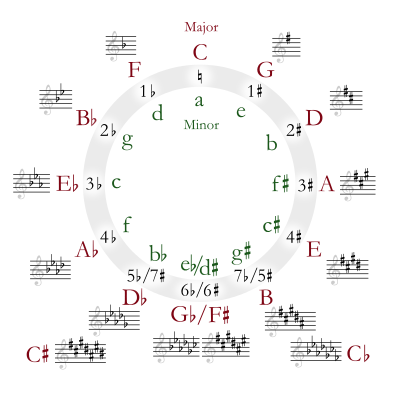B-flat minor
 | |
| Relative key | D♭ major |
|---|---|
| Parallel key | B♭ major |
| Dominant key | F minor |
| Subdominant | E♭ minor |
| Component pitches | |
| B♭, C, D♭, E♭, F, G♭, A♭, B♭ | |
B♭ minor or B-flat minor is a minor scale consisting of the pitches B♭, C, D♭, E♭, F, G♭, and A♭. Its key signature has five flats. The harmonic minor scale would use an A♮ instead of A♭.
Its relative major is D-flat major, its parallel major is B-flat major and its enharmonic equivalent is A-sharp minor.
B-flat minor is traditionally a 'dark' key.[1] Important oboe solos in this key in the orchestral literature include the second movement of Tchaikovsky's Symphony No. 4, which depicts "the feeling that you get when you are all alone", in Tchaikovsky's words. Tchaikovsky's Piano Concerto No. 1 is also in B-flat minor. An Alpine Symphony by Richard Strauss begins and ends in B-flat minor.
The old valveless horn was barely capable of playing in B-flat minor; the only example found in 18th-century music is a modulation that occurs in the first minuet of Franz Krommer's Concertino in D major, Op. 80.[2]
In classical music
- Samuel Barber's Adagio for Strings
- Frédéric Chopin's Piano Sonata No. 2,[3] Nocturne Op. 9 No. 1,[4] Scherzo No. 2[5]
- Sergei Rachmaninoff's Piano Sonata No. 2[6]
- Dmitri Shostakovich's Symphony No. 13 and String Quartet No. 13
- Pyotr Ilyich Tchaikovsky's Piano Concerto No. 1,[7] Sérénade mélancolique and Marche Slave
- Sir William Walton's Symphony No. 1
Notable songs
Notable songs written in B-flat minor include:
- "Perfect Day" by Lou Reed[8]
- "Say Say Say" by Paul McCartney and Michael Jackson[9]
- "Sunday Bloody Sunday" by U2[10]
- "Part-Time Lover" by Stevie Wonder[11]
References
- ↑ Wilfred Mellers, "Round and About in Górecki's Symphony No. 3" Tempo 168 3 (1989): 23
- ↑ J. Murray Barbour, Trumpets, Horns, and Music (1964), p. 163
- ↑ Piano Sonata No. 2, Op. 35 (Chopin, Frédéric): Scores at the International Music Score Library Project
- ↑ Nocturnes, Op. 9 (Chopin, Frédéric): Scores at the International Music Score Library Project
- ↑ Scherzo No. 2, Op. 31 (Chopin, Frédéric): Scores at the International Music Score Library Project
- ↑ Piano Sonata No. 2, Op. 36 (Rachmaninoff, Sergei): Scores at the International Music Score Library Project
- ↑ Piano Concerto No. 1, Op. 23 (Tchaikovsky, Pyotr): Scores at the International Music Score Library Project
- ↑ "Perfect Day" sheetmusic
- ↑ "Say Say Say" sheetmusic
- ↑ "Sunday Bloody Sunday" sheetmusic
- ↑ "Part-Time Lover" sheetmusic
External links
 Media related to B-flat minor at Wikimedia Commons
Media related to B-flat minor at Wikimedia Commons
| Diatonic scales and keys | |||||||||||||||||||||||||||||||||||||||||||||||||||||||
|---|---|---|---|---|---|---|---|---|---|---|---|---|---|---|---|---|---|---|---|---|---|---|---|---|---|---|---|---|---|---|---|---|---|---|---|---|---|---|---|---|---|---|---|---|---|---|---|---|---|---|---|---|---|---|---|
 |
| ||||||||||||||||||||||||||||||||||||||||||||||||||||||
| The table indicates the number of sharps or flats in each scale. Minor scales are written in lower case. | |||||||||||||||||||||||||||||||||||||||||||||||||||||||